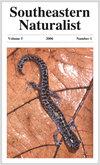Examination of Plains Spotted Skunk (Spilogale interrupta) Burrow Systems
IF 0.4
4区 环境科学与生态学
Q4 BIODIVERSITY CONSERVATION
引用次数: 0
Abstract
Abstract - Spilogale interrupta (Plains Spotted Skunk) and other species within the Spilogale genus have often been documented as using burrows for cover; however, schematics of a Plains Spotted Skunk burrow have only been documented once in the literature. While recovering 2 GPS radio transmitters in the Katy Prairie region of Southeast Texas, we excavated 2 active Plains Spotted Skunk burrows. Herein, we describe the schematics of 1 system that likely was excavated initially by a Geomys breviceps (Baird's Pocket Gopher) and the general schematics of a second burrow system frequently used by a different radio-collared individual. Both systems contained an obstructed entrance and a detritus-filled central cavity and were in locations higher in elevation than the surrounding matrix. Our observations further confirm the 3 requirements for Plains Spotted Skunk diurnal rest-location usage—protection from predation, thermoregulatory benefits, and protection from inclement weather—while providing additional insight into the intricacies of the burrow system itself. Further research into the structure of Spilogale burrows is needed to improve future conservation and management efforts of the genus.平原斑臭鼬(Spilogale interrupta)洞穴系统的检查
摘要:平原斑臭鼬(Spilogale interrupta)和其他种类的臭鼬经常使用洞穴作为掩护;然而,平原斑点臭鼬洞穴的示意图在文献中只被记录过一次。在德克萨斯州东南部的凯蒂草原地区回收2个GPS无线电发射机时,我们挖掘了2个活跃的平原斑点臭鼬洞穴。在这里,我们描述了一个系统的原理图,可能最初是由一个Geomys breviceps (Baird's Pocket Gopher)挖掘的,以及另一个经常被不同的无线电项圈个体使用的第二个洞穴系统的一般原理图。这两个系统都包含一个阻塞的入口和一个充满碎屑的中央空腔,并且位于比周围基质更高的位置。我们的观察进一步证实了平原斑臭鼬白天休息地点的3个要求:保护免受捕食者的侵害,体温调节的好处,以及保护免受恶劣天气的影响,同时为洞穴系统本身的复杂性提供了额外的见解。为了进一步提高该属植物的保护和管理水平,需要对其洞穴结构进行深入的研究。
本文章由计算机程序翻译,如有差异,请以英文原文为准。
求助全文
约1分钟内获得全文
求助全文
来源期刊

Southeastern Naturalist
环境科学-生态学
CiteScore
1.20
自引率
16.70%
发文量
31
审稿时长
18-36 weeks
期刊介绍:
The Southeastern Naturalist covers all aspects of the natural history sciences of terrestrial, freshwater, and marine organisms and the environments of the southeastern portion of North America, roughly bounded from North Carolina south to Florida, west to Texas, north to Oklahoma, and east back to North Carolina. Manuscripts based on field studies outside of this region that provide information on species within this region may be considered at the Editor’s discretion.
 求助内容:
求助内容: 应助结果提醒方式:
应助结果提醒方式:


